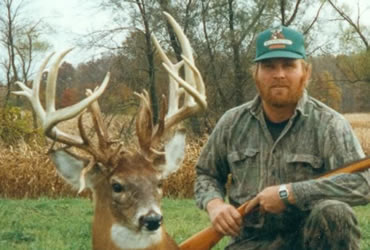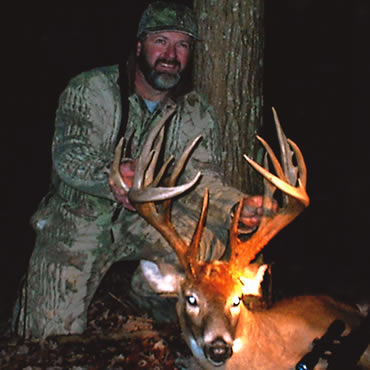B&C and Buckeye Big Bucks recognize Brian Stephens’ Highland County whitetail as an Ohio record. An even bigger deer holds the No. 1 spot in the BTR.
Regardless of which record book you’re holding, Ohio’s No. 1 muzzleloader buck — whether you call it non-typical or irregular — hails from Highland County. But it won’t be the same deer.
The 2009 deer season will be remembered as the best in history for monstrous bucks, particularly in Ohio. Chief among last season’s bruisers was a Highland County whitetail smoked during the late-November firearms season by Brian Stephens of Clayton.
Even before the deer was officially scored for the Boone and Crockett and Buckeye Big Buck clubs in January, it garnered more publicity than the much larger world-record Beatty Buck did back in 2000 — testament both to increased Internet traffic and, for lack of a better term, the “wow” factor.
Deer hunters’ taste in antlers vary considerably. Some drool over the gnarliest racks Mother Nature can produce, while others would shun what they call freaks in order to shoot a respectable typical. In other words, if the Mike Beatty Buck were standing beside the Brad Jerman Buck (the Ohio deer that’s a world-record “Perfect” in the BTR’s crossbow category), just as many people would aim for the latter as the former, despite the Beatty Buck’s nearly 100-inch advantage.
Stephens’ photogenic deer, however, would appeal to everyone. It has an amazing typical 5x4 frame — so strong, in fact, that the additional 31 inches of irregular growth almost go unnoticed.
Start with main beams of 34 1/8 and 35 1/8 inches, the longest ever recorded by anyone’s yardstick. With the help of four typical tines that exceed the 14-inch mark and great mass, the Stephens Buck is pushing the 200-inch mark even without the 31 irregular inches — and that’s not including a 24 3/8-inch inside spread!
These measurements, combined with excellent field photos and Brian’s humble demeanor, led to unparalleled publicity. The first stories speculated over the deer’s record-breaking potential. The latter ones, published after the antlers were officially taped by B&C, touted it as a new Ohio muzzleloader record.
Indeed it is, but not in “Buckmasters Whitetail Trophy Records.”
If you’re not into crunching numbers, or if you’re not a trivia buff, you can stop reading right here. If, however, you’d like to know the rest of the story — what very few people know and what nobody else has said — then plow ahead.
This isn’t the first or biggest buck to have called Highland County home.
Two Ohio whitetails in the BTR’s blackpowder category actually have more antler. Tom Luschek’s 1994 buck, also from Highland County, has 14 more inches than the Stephens Buck — 239 3/8 to 225 3/8. His deer has never been taped for B&C or Buckeye Big Bucks.
The BTR’s No. 2 blackpowder buck for Ohio is Virgil Laxton’s 2004 buck from Scioto County, which, at 232 3/8, has 7 more inches of bone. The other scoring organizations have measured the Laxton Buck, but deductions knocked its net B&C score below the Stephens Buck’s final tally.
The story behind Brian Stephens’ harvest was published in the August 2010 issue of Rack magazine. Following are the stories behind the pair of bucks that outrank it in the BTR.
 THE LUSCHEK BUCK
THE LUSCHEK BUCK
Tom Luschek of Lynchburg, Ohio, rarely hunted in the mornings during the mid-1990s. There was always too much work to be done around the family’s dairy farm in Highland County.
“By the time we finish the milking, dawn has already come and the opportunity to take a buck at first light is long gone,” he said in a 1999 interview. “Accordingly, I had to adjust my hunting style to take advantage of midday deer activity.”
Such was the case on Jan. 6, opening morning of Ohio’s 1993-94 blackpowder season. It was 8:30 before Tom and a friend, Grant Young, could make it to the woods behind the family barn. Soon after they arrived, they came across two fresh sets of deer tracks in the new snow. One hoofprint was weird-shaped; the other was made by an unusually big foot.
Both were bucks, and Grant got an opportunity from about 50 or 60 yards. But the percussion cap on his muzzleloader failed to ignite the powder charge, and the bucks eased off into an alfalfa field.
While Grant stayed behind to try another cap and fire a shot, Tom kept following the tracks. The bucks went into a hilly area full of tall grass and weeds, except for a sapling-studded depression with standing water.
“I followed the tracks into the area, easing ahead a few steps at a time while looking for the whitetails,” Tom said. “About the third time I stopped to take in my surroundings, I looked into the waterway and saw the same big rack I had seen roughly two months earlier (atop a deer he’d missed).”
The wind blowing his scent at a right angle to the buck 100 yards away, Tom immediately dropped to his knees and began crawling slowly forward.
“I’d left my binoculars in the truck, and my Kentucky rifle was equipped only with iron sights,” he explained. “I didn’t even have a scope to help me study the buck and find an opening for a shot.”
After half an hour, when he was runnng out of cover, Tom decided to take the 85-yard, broadside shot.
“I touched her off,” he said. “That was the fourth time I’d brought the rifle to my cheek.”
The .45-caliber round ball — propelled by 90 grains of Pyrodex — sliced through the top of the buck’s heart.
 THE LAXTON BUCK
THE LAXTON BUCK
Thanks to trail camera photographs, Virgil Laxton of Lucasville, Ohio, knew that a one-of-a-kind whitetail was passing through his 50 acres in Scioto County. His neighbor, Dennis May, was also collecting a stack of photos of the buck, not to mention the previous year’s shed.
Virgil had to work half a day on a cold and dreary Dec. 27, opening morning of Ohio’s 2004 muzzleloader season, but he was in his stand by 3:30.
He heard footfalls an hour later, which he dismissed as squirrels. When the noise resumed 20 minutes after that, he finally saw what was responsible: the buck with the familiar and outstanding rack.
When the rascal stopped within 60 yards, Virgil had a clear shot at vitals — though the buck’s head was behind a tree. After the boom, the deer ran 60 yards and collapsed.
Virgil’s first call went to Dennis’ wife (he was also hunting). He telephoned his brother, Frank, and his daughter and son-in-law, Louanna and Ray Akers, too. All of them came to help get the deer out of the woods.
MORE THAN INCHES
If the late NASCAR legend Dale Earnhardt was correct in his “Second Place is just the first loser” assessment, then third place must be the second loser. That might be true if you’re aiming for the winner’s circle in racing, but it ain’t so when it comes to big deer.
Line the Stephens Buck alongside the two higher-ranked Ohio whitetails, and almost everyone would choose it. Framed certificates and a listing in a record book pale in comparison to that glass-eyed trophy on your wall. By that yardstick, Brian’s buck is beyond compare.
Editor’s note: Another dandy Ohio buck has been taken since this article appeared in Buckmasters, pushing the Stephens buck into the No. 4 spot in Buckmasters Trophy Records. To see the new No. 3 buck, visit here.
Read Recent Articles:
• Shades of Gray: Sometimes doing the right thing isn’t as easy as it should be.
• The Forest for the Trees: What whitetail hunters need to know about forest habitat.
• A Blood Trail to Nowhere: A lost deer might not get eaten by a hunter, but it doesn’t go to waste.
This article was published in the November 2010 edition of Buckmasters Whitetail Magazine. Subscribe today to have Buckmasters delivered to your home.